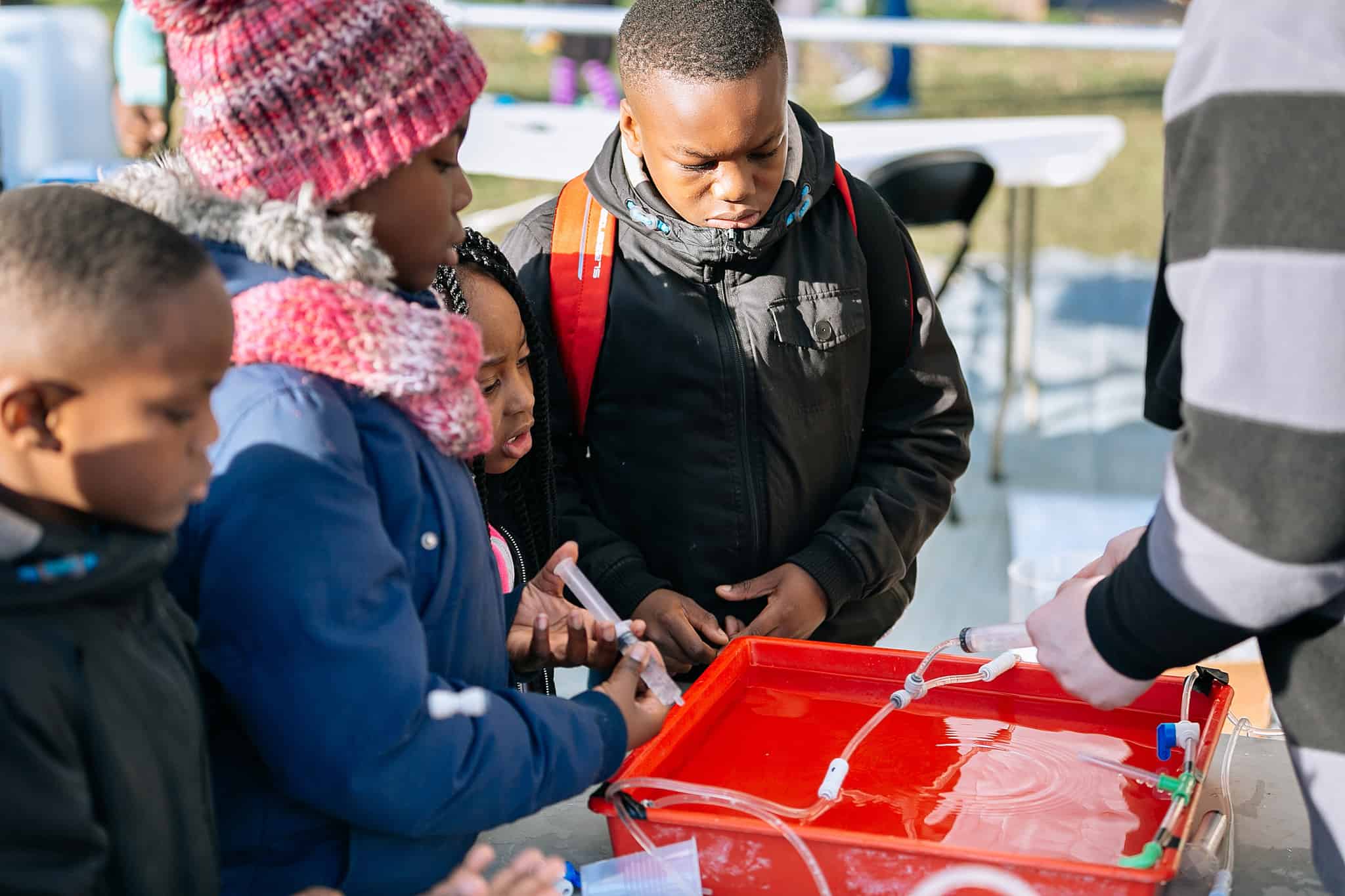
The need to engage and inspire the next generation to consider a career in engineering is one of industry’s most talked about challenges.
But what does an effective STEM (Science, technology, engineering and maths) engagement strategy actually look like? How do we measure its impact? And with a plethora of initiatives underway of varying size and scale, how do we ensure that industry is using every tool at its disposal to shore up the pipeline of future engineering talent?
This is Engineering Engagement, a special one-day event held at the Royal Academy of Engineering late last year, brought together some of the UK’s leading voices in STEM engagement in an effort to answer some of these questions, share best practice and explore the potential challenges and benefits of taking a more joined-up approach to this incredibly complex issue.
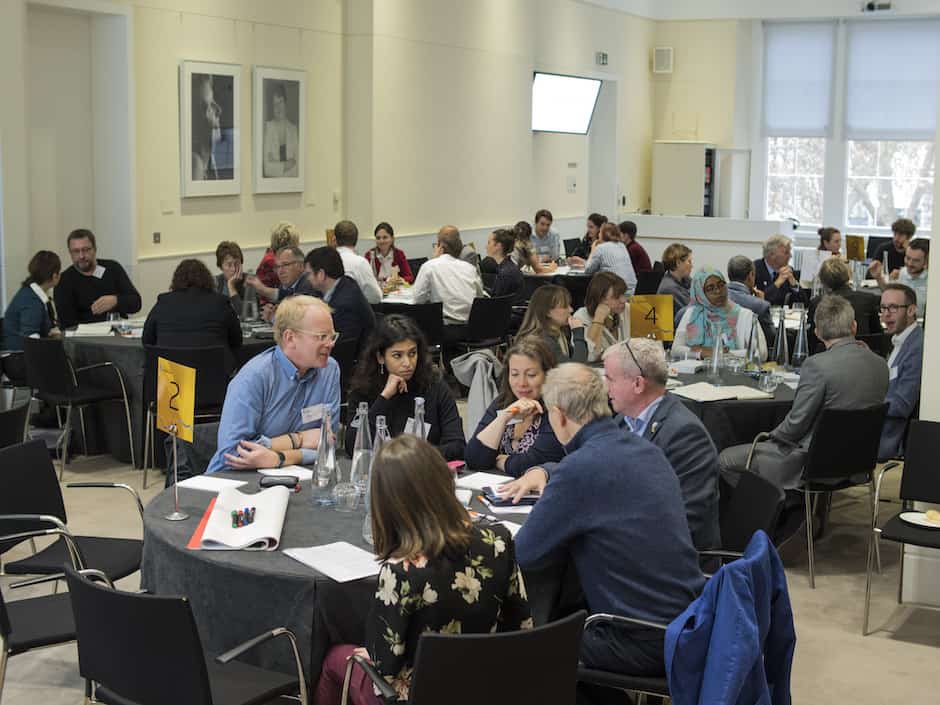
Setting the scene for the day, the academy’s Director of Engineering and Education Dr Rhys Morgan provided a sobering reminder of the challenge industry faces.
With an annual shortfall of between 40,000 to 60,000 of the 130,000 engineers and technicians industry requires every year, inspiring children to view a career in the sector more positively is, he said, a critical challenge. And one of the keys to addressing this is understanding what’s driving a dramatic decline in interest in maths and physics between GCSE and A-Level. “Roughly 600,000 take GCSEs in May,” he said, “half will get good grades in maths and physics and are well placed to progress to do engineering. Then there’s a “massive collapse”. By Sept when they start their A-levels we lose about 95 per cent of our cohort.”
There are, he explained numerous organisations doing things to try and solve this problem: no fewer than 35 different institutions, 70 science learning institutions, and over 500 STEM activity providers. This includes the Academy itself which runs the Ingenious programme (the only dedicated grant funding scheme for public engagement in engineering) and has been a driving force behind campaigns like This is Engineering and the UK government's 2018 Year of Engineering.
But despite more than a decade of such activities the overall problem remains infuriatingly resistant to change. And according to UCL sociologist Professor Louise Archer that’s partly because many activities haven’t been based strongly enough on evidence and a clear understanding of the problem.
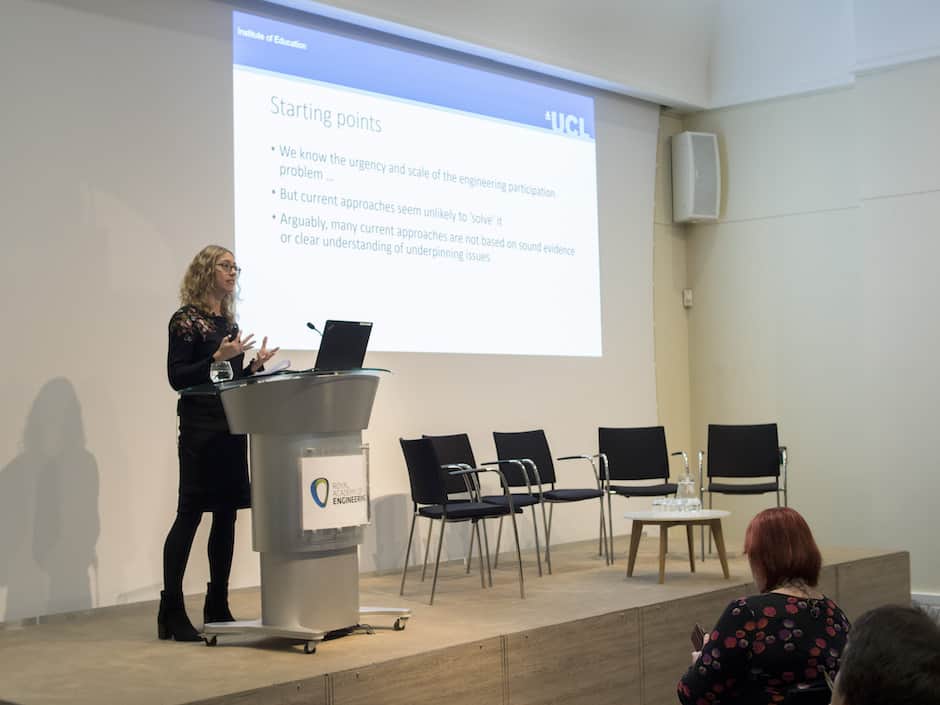
Archer has led some of the seminal work in this field, most notably the ASPIRES project: a ten-year study that has explored how young people form ideas around STEM.
During the study Archer’s group followed a cohort of pupils from the age of 10 to 18 as well as carrying out a series of large scale surveys involving around 40,000 individuals.
It led to some key observations on young peoples’ attitudes to science that help explain why the engineering sector struggles to attract the diverse range of people it so desperately needs.
For instance, one issue it identified is the way in which physics is aligned with masculinity. As Archer explained to delegates, the research evidence shows that girls’ higher attainment in the subject when compared to boys is often explained away by teachers saying that girls work hard but that boys have a raw talent. As a result boys taking part in the study were more likely to agree that their teacher thinks they’re good at physics than girls.
The study has also raised questions about elitism of physics and the way in which it is aligned with the concept of innate “cleverness” in a way that other subjects aren’t”. It is, she said, much harder for certain young people – in particular girls - to feel clever and to be recognised as being naturally clever. “They tend to be seen as working hard,” said Archer, “and working hard is seen as the opposite of being naturally clever.”
Addressing this issue is vital she said: “We cannot leave institutions like engineering or physics untouched in their elite-ness and just expect to widen participation, we have to give up some privilege and make it less special if we want to widen participation.
The many findings from ASPIRES have helped Archer’s group refine and introduce a concept that many agree can be used as the basis of a far more thoughtful approach to STEM engagement: Science Capital.
This is a way of measuring an individual’s relationship with science that helps shed light on why particular social groups remain under represented and why many young people do not see science careers as being for them. It takes into account how a host of factors including what you know about science, how you think about it, what science related activities you do and who you know influence your attitude to STEM.
Taking all of these factors into consideration when shaping engagement activities is, explained Archer, the key to broadening participation. “An approach like the science capital teaching practice whether it’s applied to school science or out of school engagement can really help. It’s not just about showing them an engineering activity – it’s also how that’s framed. We think that approach could help more young people feel like “it could be for me”.
It’s a highly complex approach, more nuanced than industry’s traditional idea that all it takes to attract kids to engineering is a few explosions, but it’s already being widely embraced by both large corporations and independent STEM initiatives and speakers at the event were quick to rubbish the suggestion made by one delegate that we risk over-intellectualising the challenge.
“If you’re going to be effective, you need to operate on a large scale in order to reach enough kids in order to democratise the opportunities,” said Shane McCracken founder of online engagement initiative I’m an Engineer, get me out of here. “You’ve got to think about what you’re doing to ensure that you’re not just shooting from the hip and doing what we’ve always done,” he added. “You’ve got have a clear understanding of how the wider population view STEM. Unless you think about it, you’re going to work from your own personal perspectives and that has been a large part of the problem to date in terms of providing more diversity within engineering.”
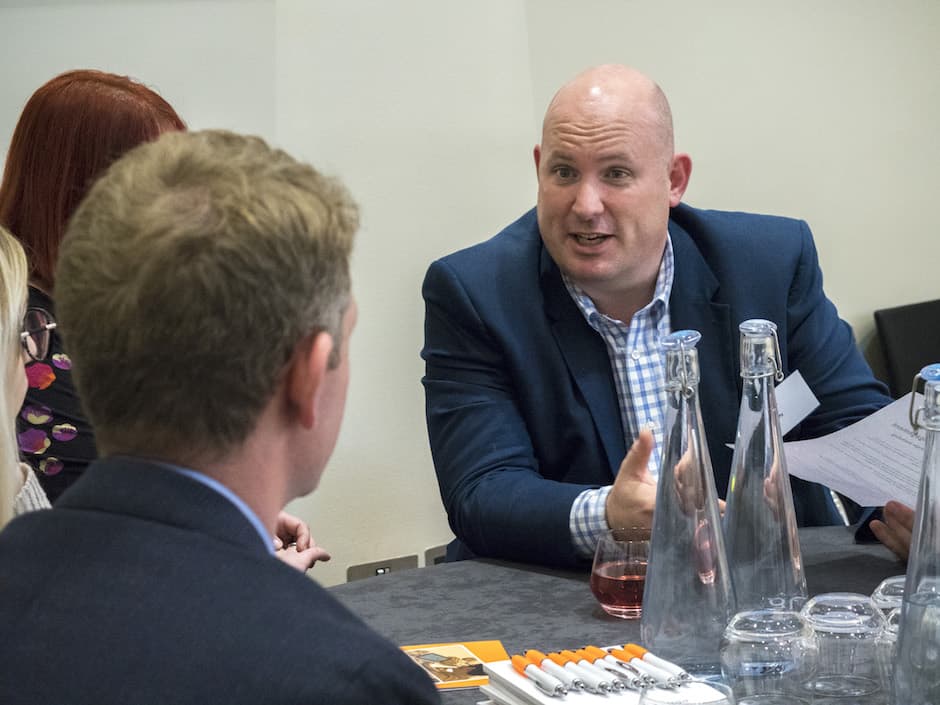
McCracken’s comments were echoed by Ian Duffy, Head of UK communications and community development at BP. “There’s a huge amount of money, time effort and resources gone in over the last 40 years into STEM outreach and it’s not made a whole deal of difference,” said Duffy. “The science capital model is incredibly helpful in understanding why that is the case, and it’s because most of the engagements have gone down very narrow channels that barely touch the sides of things that influence young people. Generally it’s been about inspiration activities in schools but they only make a difference if they’re in sufficient frequency and volume and planned into the curriculum and properly supported by teachers.”
With this bigger picture in mind, BP’s own STEM work has tended to focus on capacity building rather than direct engagement Duffy explained. For instance, as well funding a big chunk of Professor Archer’s work, the firm has also joined forces with the London Science Museum to found the Academy of Science Engagement, an organisation set up to improve and co-ordinate informal science learning across the country.

Other large corporations present at the event and equally engaged with the importance of the science capital approach included Siemens and Rolls-Royce Plc. Commenting on the strategic business importance of trying to impact the wider world Paul Broadhead, head of community investment and education outreach at Rolls-Royce, said: “we need diverse talent coming into the sector – and in the long-term a more STEM literate society has a circular impact to Rolls-Royce.”
But arguably the most compelling examples of engagement in action came from the independent practitioners, specifically “I’m an Engineer” an online engagement initiative for schools; SMASHfestUK, an annual disaster movie themed science festival targeted at deprived communities; and the phenomenally successful Code Club, a volunteer-led after school coding club for 9 – 13 year olds that now involves 200,000 children at any one time.
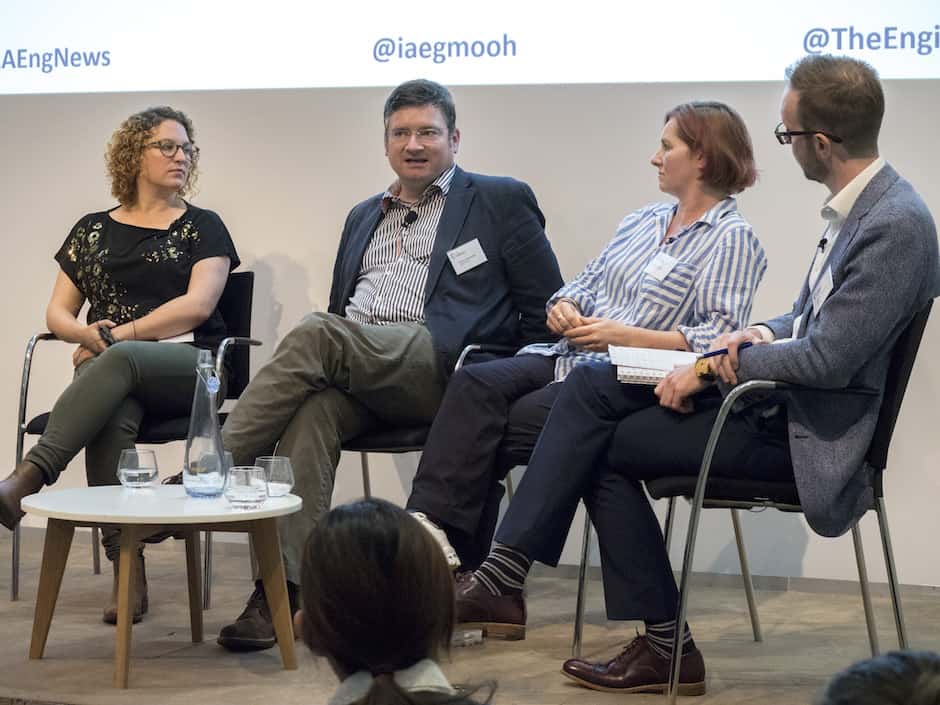
All three of these projects contain valuable lessons on how to structure STEM activities to reach underserved audiences.
I’m an Engineer founder Shane Mcracken highlighted research showing that young people from areas further away from Universities were less likely to benefit from outreach and therefore less likely to go to university themselves. Online engagement, he argued, creates an equality of opportunity that cuts through these geographical barriers. Meanwhile, SMASHFest founder Dr Lindsay Keith, talked about the importance of involving the wider community of parents and families and how that helps builds science capital.
Finally, Code Club founder Claire Sutcliffe, put the initiative’s success down to the way in which it has ensured it’s relevant. “We try to make content relevant to the children we’re trying to reach, we spent a lot of time asking them what they’re interested in. It’s a route to learning how to code but they don’t notice “a bit like sneaking vegetables into food.”
How to really help - top tips for corporate giving
Code Club founder Clare Sutcliffe offered delegates some top tips on how big organisations can make sure their STEM charity donations actually mean something.
- Try not to ring-fence your donations for certain activities. The charity has spent a lot of time thinking about how to spend funds – trust them.
- If they’re doing a good job gift to them next year and tell them soon.
- Try not to spread giving too thinly – it makes the financial impact less and spreads your attention among too many people.
- Try and offer non-financial support as well as funding.
- Be nice – answer their calls.
- Try not to make extra work for the charity. Minimise the effort needed to apply for funding – think about who you want to fund and why.
- Be very clear about your strategy and decision-making process.
- Try not to make the charity waste valuable resources on you.
- Think carefully before asking anything of a charity that doesn’t focus on their core work.
A great book to sit alongside Clare’s advice is ‘It ain’t what you give…’, with supporting blog and resources from Caroline Fiennes
Clearly, anyone looking to build a STEM activity could learn a lot from any of these practitioners. The big question is, is there an appetite for collaboration, and are the corporates prepared to listen?
While the dialogue in the room was promising, McCracken believes there’s still a long way to go and that although big organisations like BP, Rolls Royce and Shell are at the heart of the intelligent discussions that need to take place, there are huge numbers of smaller engineering firms for whom it’s not front of mind. It’s only by bringing these firms on board that we can really begin to move the dial he said.
BP’s Ian Duffy agreed that it’s essential that everyone gets involved, and that big companies make sure that they’re tapping into the expertise of independents. “Look at the range of influences wrapped around a young person and the choices they make and it’s not just school: it’s family, friends, their environment, the media , the whole societal context - by definition you need everybody working alongside each other to change those influences on young people and that’s why big corporations on their own won’t solve it.”
Beyond the things that individual organisations can do, Louise Archer believes organisations also need to work together to address some fundamental broader issues.
For instance, one of the keys to broadening participation, she said, is avoiding getting too bogged down in proscriptive definitions of what is or isn’t engineering. The widely-held notion that protecting the term “engineer” will somehow solve the sector’s skills problems is, she said, particularly unhelpful. “Although there’s a rationale to it, I think it works against the project,” she said. “All we want to do is keep nudging people to the next step, the more we try and tightly define boundaries the more it can exclude people. Engineering is quite a loaded term in the UK….so I think there are options for softening and broadening some of the boundaries.”
At the same time Archer believes we should be careful not to oversell the cool glossy version of engineering in an effort to win over young people. “I can see the logic of why people want to promote a diverse image, but if the reality of the engineering profile is that it’s not 50% women, it’s not ethnically representative then is there not an ethical issue there?” Young people are not daft, most of them know what it’s like, and it’s important that a woman or minority ethnic person is prepared for going into a situation like that.”
Beyond that, she said, there is also a pressing need to reform the education system.
“We have a system makes it so hard for young people to continue in school science - post 16… we have in our data lots of young people who are interested in science and engineering but they cannot continue because we block their entry, particularly through A-Level physics. This is disrupting efforts to engage and there’s a strong case for lobbying for change.”
Additional Resources
Science capital and engagement
- www.bp.com/sciencecapital - focusing on the work developed during Enterprising Science (with UCL and Science Museum Group)
- www.ucl.ac.uk/ioe-sciencecapital (the ongoing UCL research into science capital)
- http://www.publicengagement.ac.uk/nccpe-projects-and-services/nccpe-projects/national-forum-public-engagement-stem/underserved-audiences-stem - one-stop shop for engaging underserved audiences
- https://www.britishscienceassociation.org/our-audience-model - British Science Association audience definition model
Engaging with audiences
- https://www.stem.org.uk/stem-clubs - setting up or supporting a STEM club (includes a wide range of options and a comprehensive handbook)
- https://www.stem.org.uk/stem-ambassadors - STEM Ambassadors programme to support employee engagement with schools and community organisations
- https://group.sciencemuseum.org.uk/academy - Science Museum Group Academy
- https://www.tomorrowsengineers.org.uk/volunteers/overview/ - Tomorrow’s Engineers volunteering
This is Engineering Engagement took part on 16th November, 2018 and was jointly organised by the Royal Academy of Engineering, I’m an Engineer and The Engineer.




April 1886: the Brunkebergs tunnel
First ever example of a ground source heat pump?